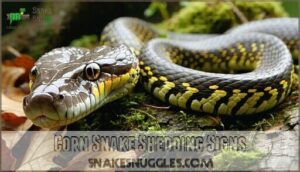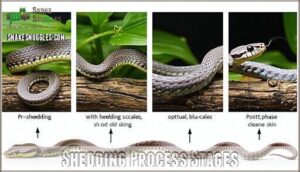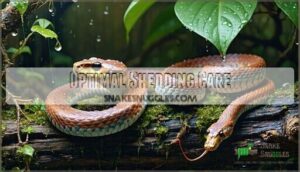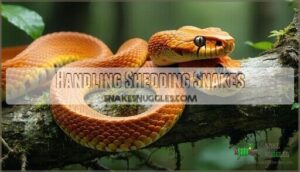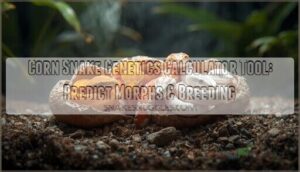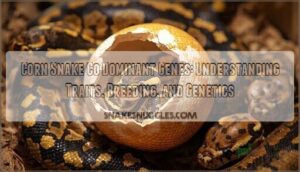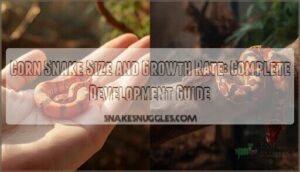This site is supported by our readers. We may earn a commission, at no cost to you, if you purchase through links.
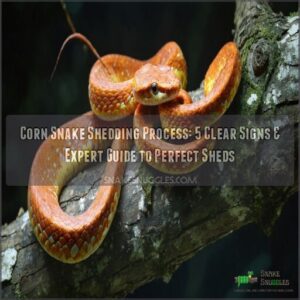
You’ll likely notice its scales look dull and its eyes turn cloudy or blue—think of it as your snake trying on blurry glasses!
During this time, it may hide more or rub against objects to loosen the old skin.
Appetite can decrease, and it might seem more restless.
After a few days, your snake will shed in one piece, leaving behind a perfect replica of its outer layer.
Want to guarantee smooth sheds?
Proper humidity, gentle handling, and rough surfaces are key.
Table Of Contents
- Key Takeaways
- Corn Snake Shedding Signs
- Shedding Process Stages
- Optimal Shedding Care
- Handling Shedding Snakes
- Shedding Health and Issues
- Frequently Asked Questions (FAQs)
- How long is the shedding process for corn snakes?
- How do I tell if my corn snake is shedding?
- Should I hold my corn snake while it’s shedding?
- What are the stages of snake shedding?
- When do corn snakes shed?
- Why do corn snakes shed their skin?
- How can I help my corn snake shed properly?
- How do you know if a corn snake is shedding?
- What Factors Can Increase Shedding Frequency in Corn Snakes?
- How Long Does the Shedding Process Take for Corn Snakes?
- Conclusion
Key Takeaways
- Keep humidity around 70% to help your corn snake shed smoothly and prevent stuck shed issues.
- Watch for signs like cloudy eyes, dull scales, and hiding behavior as indicators of the shedding process.
- Avoid handling your snake during the shedding phase to reduce stress and allow the process to happen naturally.
- Provide rough surfaces, a damp moss hide, and access to water for soaking to support healthy shedding.
Corn Snake Shedding Signs
You’ll notice several clear signs when your corn snake is preparing to shed, and these changes are easy to spot if you know what to look for.
From cloudy eyes to dull skin, each clue helps you understand your snake’s natural process, including recognizing signs like dull skin.
Changes in Eye Color and Appearance
One of the most telltale shedding signs in corn snakes is the dramatic change in eye appearance.
The dramatic eye color shift is a key shedding sign, revealing nature’s preparation for your corn snake’s transformation.
During the Blue Phase, your snake’s eyes will turn cloudy or milky blue-green, looking almost opaque.
This cloudiness occurs because fluid builds up between the old and new eye caps.
Don’t worry about their temporary visual impairment—this natural process clears up 3-4 days before actual shedding begins.
Increased Hiding and Rubbing Behavior
During the shedding process, your corn snake’s hiding and rubbing behavior will increase noticeably.
You’ll observe your pet seeking out secure spots more frequently as a primary shedding sign.
Here are 5 specific hiding and rubbing behaviors to watch for:
- Increased time spent in hides
- Frequent rubbing against rough surfaces
- Nose-rubbing against tank decorations
- Seeking out tight spaces
- Avoiding open areas of the enclosure
These behaviors are crucial signs that indicate your corn snake is about to shed its skin, and understanding them can help you provide the best care for your pet.
Changes in Appetite and Restlessness
Beyond hiding more, your corn snake’s appetite and activity level will shift during shedding.
Most snakes refuse food completely during this time.
| Behavior | During Normal Times | During Shedding |
|---|---|---|
| Feeding | Willing to eat | Feeding refusal |
| Movement | Calm exploration | Restless behavior |
| Handling response | Tolerant | Nervous or defensive |
| Activity pattern | Predictable | Increased activity |
| Stress signals | Minimal | More pronounced |
Don’t worry about appetite loss—it’s perfectly natural.
Wait until after your snake completes shedding before offering food again, as this refusal to eat is a normal part of the shedding process and snakes will resume eating once they have shed their skin.
Dull Skin and Color Changes
While your appetite changes signal shedding preparation, your corn snake’s appearance will also transform noticeably.
The once vibrant scales take on a dull, lackluster appearance as the shedding cycle progresses.
You’ll notice these key color changes:
- Your snake’s belly turns slightly pink or reddish
- Overall scale dullness develops with a whitish skin sheen
- Colors fade dramatically during the "blue phase"
These physical transformations are normal shedding symptoms that indicate your corn snake is preparing to remove its old skin, which is a natural part of the preparation process.
Shedding Process Stages
Your corn snake’s shedding cycle follows four distinct stages that help you predict exactly when your pet will shed its skin.
You’ll notice changes from the pre-shedding phase through the blue phase, actual shedding, and finally the post-shed period when your snake returns to its vibrant appearance, which marks the end of a complete cycle.
Pre-Shedding Phase
After noticing your corn snake’s shedding signs, you’ll enter the pre-shedding phase.
During this initial stage, your snake undergoes subtle behavioral changes. You might observe color dullness as the skin prepares to separate. Fluid buildup begins between old and new skin layers, though it’s not yet visible.
Your snake may become restless or hide more. Understanding the importance of Ecdysis is vital for snake owners.
Avoiding stress is key during this time to facilitate a smooth snake shedding process.
Blue Phase
When your corn snake enters the blue phase, its eyes will turn cloudy or bluish-gray due to fluid buildup between old and new skin layers.
This opaque stage typically lasts 3-7 days and signals the middle of the shedding process.
During this time, you’ll notice:
- Ghostly appearance as colors become dramatically duller
- Increased hiding behavior and reluctance to be handled
- Possible refusal of food until shedding completes
Shedding Phase
After your snake’s eyes clear up, the actual shedding phase begins. This is when all that preparation pays off! Your corn snake will start rubbing against rough surfaces to create a tear in the skin, usually beginning around the mouth.
When your corn snake begins the shedding phase, watch as it skillfully rubs away its old skin, revealing fresh, vibrant scales beneath.
Most corn snakes shed at night, so you might miss the actual process and just find the shed skin in the morning.
| Shedding Phase | What You’ll See | What To Do |
|---|---|---|
| Starting Point | Snake rubs face against objects | Provide rough surfaces |
| Middle Process | Skin peels inside-out like a sock | Don’t interrupt |
| Challenging Areas | Eye caps and tail tip | Monitor carefully |
| Completion | One-piece shed (ideally) | Check for retained pieces |
During this shedding process, it’s essential to understand the different stages, including the starting point, middle process, challenging areas, and completion, to ensure your corn snake sheds its skin successfully and safely.
Post-Shedding Phase
After your corn snake has shed its skin, you’ll notice a much brighter appearance, like it’s wearing a fresh new outfit.
Check for a complete shed, especially around the eyes and tail tip.
Now is the perfect time for enclosure cleaning while evaluating your snake’s health and growth.
Reestablish the feeding schedule once your snake shows interest in food. Don’t forget a hydration check—many snakes are thirsty post-shedding.
Optimal Shedding Care
You’ll need the right setup to help your corn snake shed its skin completely and without stress.
Maintaining proper humidity levels (around 70%) and providing rough surfaces for your snake to rub against will make the shedding process smoother and prevent health issues like stuck shed.
Humidity and Temperature Requirements
During shedding, your corn snake needs higher humidity to loosen its old skin.
Keep humidity between 60-70% by adding a larger water dish or misting the enclosure.
Maintain a temperature gradient of 75-85°F, with the warm side around 85°F.
Monitor levels with hygrometers and thermometers.
Seasonal adjustments may be necessary, and larger enclosures typically retain humidity better.
A damp moss hide offers a perfect retreat for proper shedding.
Using digital hygrometers guarantees accurate humidity monitoring.
Providing Rough Surfaces for Rubbing
To help with corn snake shedding, add textured hides, branches, and rocks to the enclosure.
These create safe abrasives, letting your snake rub off loose skin naturally. Choose smooth-edged rocks and branches to avoid injuries.
Adding appropriate reptile enclosure decor can greatly improve the shedding process.
Enclosure enrichment like this supports the shedding process but also keeps your snake active and happy, reducing shedding problems caused by insufficient rubbing surfaces.
Offering Water for Soaking
While those rough surfaces help your snake rub off old skin, water access is just as important.
Place a water bowl large enough for your corn snake to soak in during shedding.
Keep water temperature lukewarm (75-85°F) and make certain the container is secure.
You can find a suitable snake soaking bowl at many online retailers.
A 15-20 minute snake bath can work wonders for stubborn sheds, and it’s crucial to use plain water as it provides all the hydration they need, never using alternative liquids.
Monitoring for Difficulty Shedding
Watch closely for stuck shed signs, like retained eyecaps or tail tip issues.
Incomplete sheds can signal corn snake shedding complications, often tied to low humidity.
Use preventative measures like proper humidity monitoring or moist hides to prevent shedding issues.
If you spot stuck shed, act quickly with warm baths or damp towels to ease the skin’s removal, using warm baths or damp towels.
Handling Shedding Snakes
When your corn snake is shedding, it’s best to avoid handling to reduce stress and prevent skin damage.
After shedding, handle gently to check for any retained skin or other issues.
Avoiding Handling During Blue Phase
Your corn snake needs total space during the blue phase. Handling at this time increases stress and injury risk, as temperament changes make them more defensive.
You’ll notice feeding refusal and unusual behavior when their eyes cloud over – this is normal during shedding stages.
Instead of touching, use observation methods like checking through the tank to monitor their progress without disturbing them, which helps reduce the risk of injury and allows the snake to complete its shedding process in a stress-free environment.
Minimizing Stress During Shedding
Now that your corn snake is shedding, creating a gentle environment becomes your priority.
Keep the vivarium quiet and reduce movement around it.
Proper hydration is critical—maintain humidity around 70% and provide a humid hide filled with damp moss.
Secure hides offer safety during this vulnerable time.
Dim lighting helps reduce stress as your snake’s eyes are sensitive during the shedding process.
Safe Handling Practices After Shedding
Now that your corn snake has completed shedding, you can gradually return to normal handling. Wait at least 24 hours before picking up your snake to give its new skin time to adjust.
For safe post-shed handling, start with short sessions (5-10 minutes) to minimize stress. Always wash hands before and after handling to maintain hygiene.
- Check for any retained shed around eyes or tail tip during your first inspection. If you notice any, gently massaging the area with a damp cloth can help.
Shedding Health and Issues
Shedding problems, like stuck skin or incomplete sheds, can harm your corn snake’s health if not addressed quickly.
Understanding common issues and knowing how to handle them guarantees your snake stays comfortable and healthy.
Recognizing Dysecdysis
Dysecdysis, or problematic shedding, happens when stuck shed remains on your snake, often around the tail or retained eye caps.
Look for incomplete shedding or scales with strange textures. Shedding frequency issues might hint at health or humidity problems.
Don’t ignore skin patches or snake shedding difficulties—these signs reveal shedding issues needing attention to prevent future complications. Many owners seek snake shedding solutions to aid their reptiles.
Treatment of Shedding Issues
If your snake has shedding issues, a lukewarm water bath loosens stuck shed safely.
For stubborn cases, consider a humid moss hide. Removing stuck skin gently prevents injury; focus on delicate spots like the tail tip and retained eyecaps.
A reptile fogger can help maintain ideal humidity aiding in the shedding process.
Boost enclosure humidity to aid shedding treatment. These simple solutions resolve complications in reptiles, ensuring smooth and healthy snake shedding treatment options.
Promoting Healthy Shedding Habits
Healthy shedding starts with proper humidity and hydration.
Keep the enclosure around 70% humidity during the corn snake shedding process.
Add a damp hide to enrich their space and offer water for soaking.
Support your snake with a varied diet dusted with calcium and multivitamins.
Prevent stuck sheds by checking conditions regularly and following reptile shedding care tips.
Common Shedding Mistakes to Avoid
Avoiding mistakes during shedding is essential. Ignoring humidity leads to stuck shed, while forceful removal can harm delicate skin, including eye caps.
Stressful handling or using abrasive substrates only worsens issues. Make certain proper humidity for shedding and assist gently with lukewarm water if needed.
An improper diet or dehydration can also cause problems, so meet your snake’s needs consistently, including providing proper humidity and avoiding stressful handling, to prevent issues like stuck shed.
Frequently Asked Questions (FAQs)
How long is the shedding process for corn snakes?
Shedding can feel like nature’s clockwork.
For corn snakes, it takes about 7-14 days.
Their skin dulls, eyes turn cloudy, and the process ends with a fresh, sleek new layer after proper care, which can be considered as nature’s clockwork.
How do I tell if my corn snake is shedding?
You’ll notice dull scales, cloudy blue eyes, and a pinkish belly.
They may hide more, lose appetite, or act defensive.
Their colors darken during the “blue phase,” clearing up shortly before shedding.
Should I hold my corn snake while it’s shedding?
It’s best not to handle your corn snake during shedding.
They feel extra sensitive and stressed.
Give them space, provide humidity for a smooth shed, and wait until they’re finished to interact again.
What are the stages of snake shedding?
About 9-14 days—snakes shed in stages: skin dulls, eyes turn cloudy (blue phase), then clear.
Skin loosens as fluid builds between layers.
When do corn snakes shed?
Corn snakes shed their skin every 4-6 weeks when young, about every 3-4 months as adults.
This natural cycle helps them grow or adjust to size changes, often happening at night and unnoticed, which can be considered a natural process.
Why do corn snakes shed their skin?
Snakes shed their skin to grow or heal and maintain healthy scales.
Since their skin doesn’t stretch, shedding removes the old, tight layer, allowing space for their expanding size and replacing damaged or worn scales.
How can I help my corn snake shed properly?
Think of shedding like a snake’s reset button.
Keep humidity around 70%, provide a damp hide with moss, and avoid handling.
If shedding issues arise, a lukewarm bath or gentle soak can help.
How do you know if a corn snake is shedding?
You’ll notice dull scales, cloudy eyes, and a pink belly when your snake’s ready to shed.
It might hide more, skip meals, or rub its nose on surfaces to loosen old skin.
What Factors Can Increase Shedding Frequency in Corn Snakes?
Imagine a young snake growing quickly—it’ll shed often to keep up.
Factors like rapid growth, a rich diet, injury repairs, or breeding cycles can all speed up shedding.
Watch for signs to guarantee proper care.
How Long Does the Shedding Process Take for Corn Snakes?
The shedding process for corn snakes usually takes about 7 to 14 days.
You’ll notice their colors dull and eyes cloud over ("going blue") before clearing up, followed by the actual shedding a few days later.
Conclusion
Shedding is a natural part of your corn snake’s life, and knowing the process is worth its weight in gold.
By recognizing the signs, like cloudy eyes or dull scales, and understanding the corn snake shedding process, you’ll help your pet shed smoothly and stay healthy.
Keep its enclosure humid, provide rough surfaces, and watch for stuck skin. A little preparation goes a long way in supporting perfect sheds. Your snake’s healthy glow depends on it, and this is crucial for its overall healthy condition, ensuring a smooth shedding experience.

